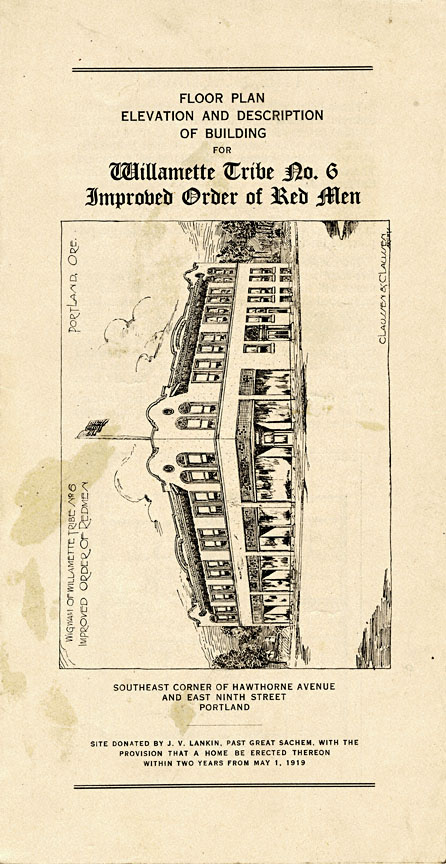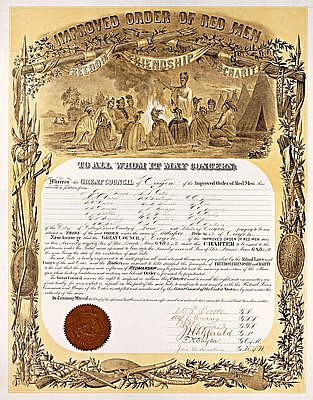- Catalog No. —
- Mss 1696-3
- Date —
- 1919
- Era —
- 1881-1920 (Industrialization and Progressive Reform)
- Themes —
- Architecture and Historic Preservation
- Credits —
- Oregon Historical Society
- Regions —
- Portland Metropolitan
- Author —
- Willamette Tribe No. 6, Improved Order of Red Men
Floor Plan of Red Men Hall, Portland
This pamphlet, “Floor Plan Elevation and Description of Building for Willamette Tribe No. 6 Improved Order of Red Men,” was created in 1919 to provide detailed information about the planned layout of Red Men Hall, located in Portland on SE Hawthorne Boulevard and 9th Avenue. The Improved Order of Red Men (IORM), incorporated in 1835, is the oldest homegrown fraternal society in the United States.
The grounds for Red Men Hall were donated to the Willamette Tribe of the IORM by long-time member John V. Lankin in May 1919. According to the front page of this pamphlet, Lankin donated the land “with the provision that a home be erected thereon within two years from May, 1919;” however, Red Men Hall was not built until 1922. The building itself was designed in the California Mission Revival style (popular in Portland in the late 1910s and early 1920s) by the architectural firm of Clausen & Clausen. The building was planned as a multipurpose property, with space for four storefront businesses, two 5-room residential apartments, and a variety of uses to meet the needs of the Willamette Tribe (including billiards, banquet, and social rooms, a lodge hall, and office space). Red Men Hall’s location on Hawthorne Boulevard also made it easily accessible by streetcar.
The Willamette Tribe No. 6, Improved Order of Red Men, was officially incorporated in the state of Oregon for the “mutual relief of its members, charitable pursuits, and the administration of privileges honors and benefits [sic]…of the Improved Order of Red Men” on March 23, 1876. Like other “tribes” of the IORM, members paid regular dues that were used to provide relief in times of sickness, costs associated with funerals, aid for widows, and assistance in the placement and care of deceased members’ children who were at risk of being sent to orphanages. In this respect, the IORM was not very different from other mutual benefit societies like the Odd Fellows. What set the Red Men apart from other fraternal groups was their adoption of “emblems, ceremonies, customs, and signs of the American Tribes,” whom they claimed to be “the inspiration of true liberty” for the rebels of the American Revolution.
During the Great Depression, the Willamette Tribe came on hard times and fell behind on payments for Red Men Hall. In February 1933, some of the Red Men, in an attempt to keep their tribe afloat, signed a formal agreement stating that they would not cash in their bonds that they had previously bought to cover the cost of building Red Men Hall. According to the agreement, the concession was made “for the reason that the conditions in the City of Portland, as elsewhere, have impaired the financial ability of the order to keep up their expenses and pay the coupons on said indebtedness at this time.” Membership continued to decline through the 1930s, and in 1941, the Willamette Tribe was officially dissolved.
Further Reading:
Knobel, Dale T. “To Be An American: Ethnicity, Fraternity, and the Improved Order of Red Men.” Journal of American Ethnic History 4:1, 1984: 62 – 87.
Deloria, Philip J. Playing Indian. New Haven, Conn., 1998.
Written by Joshua Binus, © Oregon Historical Society, 2006.

